In order to have accurate performance, industrial resistors are equipped with measurement, protection and control equipment. According to customer’s request, PAARSUN Co. installs Accessories on its industrial resistors. The accessories are as follows:
1- Current Transformer (CT)
2- Potential Transformer, Voltage Transformer (PT, VT)
3- Earthing Transformer, Grounding Transformer
4- Surge Arrester, Lightning Arrester
5- Protection Relay
6- Disconnector Switch
7- Bushing
8- Control Panel
9- Terminal Box
10- Heater & Thermostat Anti Condensing
11- Nameplate & Warning Plate
12- Blower Fan
13- Thermal Bi-metal Relay- Motor Protection Circuit Breaker (MPCB)
14- Phase Control Relay
15- Differential Pressure Switch (DPS)
16- Circuit Breaker- Disjoncteur
17- Contactor & Vacuum Contactor
18- Medium Voltage Fuse
19- Cooling Unit
20- Switch, Push Button & Emergency Stop
21- Digital Temperature & Humidity Controller
22- Programmable Logic Controller (PLC) & Human Machine Interface (HMI)
23- MCB, RCCB, RCBO
24- Multi-function Meter
25- Cam Switch
26- Timer
27- Signal Lamp & Alarm
1. Current Transformer
A step-down transformer with very low rated power which is used to measure the current in power systems. This method is simple, inexpensive and accurately acceptable. These transformers generally have three structures:
- Wound Current Transformer
- Toroidal Current Transformer
- Bar-type Current Transformer
It should be noted that the two ends of the current transformer output should never be opened. It is recommended that the current transformer be located on the Incoming side of the NGR or industrial resistor and its two output ends be connected to relays and measurement equipment.
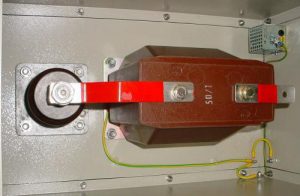
2. Potential Transformer
Voltage Transformer is a step-down transformer with very low rated power and aims to provide a sample of the power system voltage for measurement and control equipment. The voltage transformer must be very precise so as not to distort the actual voltages. Voltage transformers are made in different classes in terms of accuracy. The two voltage output terminals, unlike current transformers, should never be short-circuited.
Therefore, the main tasks of voltage transformers are as follows:
- Transform voltage from a usually high value to a value that can be used in relays and equipment.
- Isolate the measured circuit voltage from the high system voltage.
- Provide the possibility of using relays and equipment in different nominal values of current and voltage.
- Transform voltage from a usually high value to a value that can be used in relays and equipment.
- Isolate the measured voltage from the high system voltage.
- Provide the possibility of using relays and equipment in different nominal values of current and voltage.
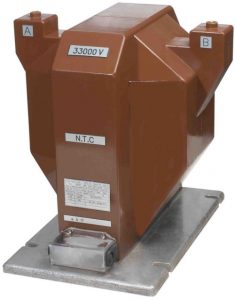
3. Earth Transformer
The main task of a grounding transformer or zigzag transformer is to create a neutral point in the secondary of the main transformer that has a delta connection and its neutral point is not available. The phases of these transformers are connected as a zigzag connection and the neutral point of this transformer can be connected to ground through NGR resistor and therefore, protect the main transformer.
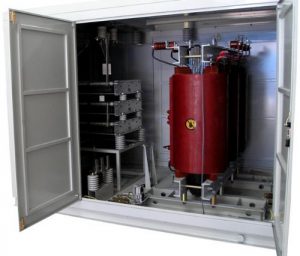
4. Surge Arrester
Surge arresters are utilized to protect power system equipment against over-voltages. This protection device limits transient over-voltages (or voltages that bring about damages to network equipment). Surge arresters can perform the above-mentioned role for many times without being damaged. The surge arresters are in parallel with the equipment under- protection (between phase and ground), and transmit the energy of the overvoltage wave to the ground. Therefore, the voltage drop due to the discharge current of the surge arrester is limited to a certain value (within the protection level of the arrester).
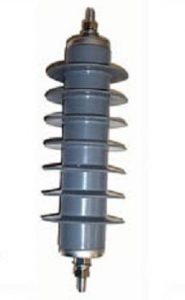
5. Protection Relay
Relays or protection equipment are devices which, at the moment of occurring fault in the network, by sending the Trip signal, brings about opening switches, and protect electrical equipment against damage and possible short-circuits. Important types of these relays used in neutral grounding resistors (NGRs) include over-current relay, earth fault relay, or earth leakage relay.

6. Circuit Breaker or Disconnecting Switch
Disconnector Switch is used to isolate the energized equipment from the power system. Unlike circuit breakers, this switch is not equipped with any mechanism for extinguishing the arc and thus, it should not be used in the energized power system. This switch can be operated by manual and motorized mechanism and its Normally Open (N.O.) or Normally Close (N.C.) contacts notifies the control unit of the status of the disconnector. By combining fuses with this switch, overcurrent faults in the system can also be protected. Simple disconnecting the downstream system, safe repair of downstream system, safety of personnel, and protection against current feedback from the secondary of the transformer are the main purposes of the disconnector switch.
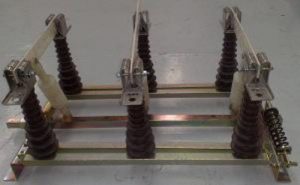
7. Porcelain Entrance Bushing
Bushing is used to bring in and out the main line to the high voltage equipment. Bushings prevent occurring arcs between the power line and the enclosure of the equipment. The bushings used in PAARSUN Co. are made of porcelain, which have a good resistance to heat and are also resistant to moisture penetration by having a glazed layer.
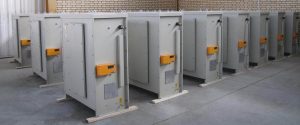
8. Control Panel
The control panel can be used to monitor various parameters of the equipment (such as voltage, current and power), control and notify the latest status of switches, contactors, alarms, errors and perform the necessary settings in Automatic mode in the equipment. Control panels made by PAARSUN Co. have Ingress Protection of IP55 and its tank material can be modified by the customer’s request. Control panel may include control equipment such as fuses, contactors, protection switches, HMI, NGR Monitoring displays, alarm windows, ground fault relays, and alarm signals for operation mode of equipment.

9. Terminal Box
The terminal box provides the required connections and outputs to the user and isolates the control section from the power circuit. The terminal boxes used in PAARSUN Co. are made of cast aluminum with IP66 protection degree. Thermostat displays can also be placed on this box and display the temperature and humidity inside the equipment. The outputs provided in terminal box may include the following:
- CT and PT secondary output
- Relay output
- Heater output
- Thermostat output
- Output related to earth terminal of equipment
- Fan output
- The N.C. and N.O. contacts of switches
- Contactor coils

10. Anti-Condensing Heater & Thermostat
Anti-humidity heaters are used to absorb moisture by raising the temperature inside the enclosure according to the dew point temperature. According to the fact that the dew point temperature varies in different geographical conditions, therefore the heater is controlled by an adjustable thermostat at the dew point. This will eliminate condensed water vapor inside the enclosure and protects the enclosure and internal equipment from corrosion.

11. Nameplate & Warning Plate
The technical specification of each equipment is shown on the Nameplate. The used plates are made of stainless steel and the specifications are engraved with a specific depth on it, so that the plates will have the desired appearance quality and appropriate durability, simultaneously. The quality of the engraved parameters on the nameplates has been evaluated and accepted through salt spray and ultraviolet radiation tests. The equipment made by PAARSUN Co. possess the highest priority in terms of safety and protection; however, to increase the awareness of the operator and personnel, warning plates that correspond to the operation of the equipment (and remind the possible hazards) are installed on it.

12. Cooling Fan
For products which are under load for a relatively long period of time and the increased temperature is not naturally eliminated, cooling fans are used in the design and manufacturing process.
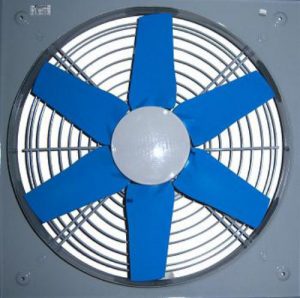
13. Thermal Bimetal Relay and Motor Protection Circuit Breaker (MPCB)
Thermal Relays (Thermal Bimetal Relay-Motor Protection Circuit Breaker) are the most common type of protection relays against overload. These relays are mechanical and temperature sensitive and are connected in series with the electromotor circuit and due to its time adjustment, it de-energizes the electromotor circuit in case of overload. Bimetal thermal relays need to be installed at the contactor output; however, the MPCB type can be used independently.

14. Phase Control Relay
Phase control relay is utilized to detect disconnection of incoming phases (single phase, two phase or all three phases) or neutral wire, phase sequence change, excessive increase or decrease of voltage, excessive three-phase voltage asymmetry, and shocks caused by energizing/de-energizing of network. The contacts of Phase Control Relay are located in the path of the control circuit and in case of any of the above-mentioned errors, it immediately de-energizes the circuit, and since the detected error is not cleared, Phase Control Relay does not allow the system to be electrified.

15. Differential Pressure Switch (DPS)
DPS is used to ensure proper operation of the blower fan in the resistors with Air Forced (AF) cooling system. This switch monitors the correct rotation of the blower fan, the appropriate operation of the electromotor and the sufficient airflow for the blower, and it has a switch point (according to the amount of air flow of the blower). Due to the extremely high sensitivity of AF-type resistors, a momentary interruption of airflow will cause irreparable damage to the resistor. In this case, the DPS has to immediately de-energize the main system so that the resistors are not damaged.

16. Circuit Breaker-Disconnector
Circuit Breaker is an automatic switch to pass high current with high voltage, and since it is equipped with arc suppression system, it is used to protect the network and load against over current and short circuit faults. This switch is also able to maneuver to disconnect/reconnect the network in the On-Load operation and its operation can be manual or motorized. Unlike MV Fuses which must be replaced with single operation against overcurrent, circuit breaker will be operational after clearing the fault.
17. Contactor & Vacuum Contactor
Contactor is an electromagnetic switch that is used to disconnect /connect the circuit in the On-Load operation of system. This switch is controllable with low voltage and it permits isolating the control unit from the power system. Unlike circuit breakers, a contactor is not used to clear short circuit current. Vacuum contactor is designed to operate at medium voltage, and along with MV fuses, it can provide overcurrent protection in addition to circuit switching.

18. Medium Voltage Fuse
Fuse is a device that protects electrical circuits against overcurrent or short circuit. This device is connected in series in the circuit and in case of occurring short circuit fault, it burns and cuts off the electric current and protects the system and loads. With single operation, the fuse must be replaced. At medium voltage, fuses are usually a good means of protection against overcurrent and thermal effects. MV fuses have advantageous characteristics such as high cut-off capacity, very high current limitation, low switching voltage, fast cut-off, no-exhaustion and etc.

19. Cooling Unit
Control panels are one of the most important parts of electrical system that must be able to control the relevant system under any circumstances. In acidic and sultry environments with high humidity and temperature, the possibility of decay and damage to the wiring of the control system, electronic equipment and controllers increases and their life will be rapidly reduced, thus affecting the performance of the control system and power system. Cooling units are one of the most effective equipment for proper cooling and ventilation of control panels and increase their life.

20. Switch, Push Button & Emergency Stop
The switches and Push Buttons are used to apply commands from the operator to the control system, and consequently, the power system starts according to the relevant control circuit. These Push Buttons can operate as Start Push Button, Stop Push Button, double (Start / Stop Push Button) or On/ Off switch. Equipment made by PAARSUN Co. have the highest safety priority; however, there may be possible risks on equipment and operators. In case of danger, by pressing the emergency stop button, the entire resistor unit will be de-energized.

21. Digital Temperature & Humidity Controller
In acidic and sultry environments with high humidity and temperature, the possibility of corrosion of resistors increases. By measuring the humidity and temperature of the environment, Digital Temperature & Humidity Controller can start the heaters inside the resistor enclosure and increase the life of the equipment.

22. Programmable Logic Controller (PLC) and Human Machine Interface (HMI).
PLC is a software-based system that receives different commands from the operator as well as measured values from the sensors, and processes the received data according to the written program stored in its memory and consequently, issue the necessary commands to contactors and operators. PLC include logic, sequencing, scheduling, counting, and computing functions. In fact, PLC is an industrial computer with a unique configuration. In addition to above-mentioned points, PLC is able to display different system conditions for easier communication with the operator, known as the Human Machine Interface (HMI).

23. Miniature Circuit Breakers (MCB), Residual Current Circuit Breaker (RCCB), Residual Current Circuit Breaker with Over Current Protection (RCBO)
MCB is a switch that provides effective protection against short circuit and overload faults and consequently, brings about de-energizing of network. Short circuit fault is detected and protected by magnetic relay and overload fault is detected by thermal relay. RCCB is a switch which detects a small leakage current in the equipment’s enclosure as well as the direct connection of the person’s body to the live enclosure, and cuts off the circuit immediately. This switch detects and cuts off all leakage currents that are not detected by the fuse but may cause fire or electric shock. RCBO has features of both MCB and RCCB, simultaneously. Therefore, the RCBO can provide protection against connection of the person’s body to the live enclosure, protection against direct contact with phases, protection against short circuit, and protection against overload.

24. Multi-Function Meter
The various parameters of the system that is connected to the resistive-inductive load can be measured. These parameters include active power, reactive power, apparent power, power factor, voltage, current and frequency. Multi-Function Meter is able to measure various electrical parameters with high accuracy, and connect to various types of CT and PT. Consequently, Multi-Function Meter will inform the operator of the condition of the load-connected system.

25. Cam Switch
Cam Switch is a mechanical disconnection/connection device that is able to connect the network or cut-off current under normal system’s condition. Moreover, Cam Switch can also pass current for a specified period of time under abnormal circuit conditions such as short circuit fault. Cam Switch is recommended for low voltage and low current systems which manual control is selected as its control system.

26. Timer
Time relays are switches that are used in the design of control circuits that require timing. These relays have N.O. and N.C. contacts that can be connected to the control system. These relays include connection-delay timer, disconnection-delay timer, disconnection/connection delay timer, and permanent connection delay timer, which can be used in manual control systems.

27. Signal Lamp & Alarm
The signal lamp can inform the operator of the various conditions of the power network and control system, and guide the operator to implement the correct decision. Signal lamps are usually utilized for three-phase input power, blower fan input power, system control mode (Manual / Automatic), blower fan operating conditions, Thermo switch operating conditions, On load or Off load condition of each steps of Load Bank, resistor temperature rise alarm, and exhaust air alarm, as well as fault conditions.

